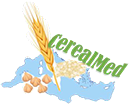The Project
Among crops and cereals, wheat is the most widely grown crop in the world (more than 200 M ha) and of significant commercial importance, because of its end-use products (pasta, couscous, bread and bulgur) that altogether accounts for ca. 20% of the daily protein and food calories. In particular, durum wheat or pasta wheat, is the cereal most relevant for the whole Mediterranean agriculture, due to its intrinsic adaptation to dryland, semi-arid environments and to its strong hystorical cultivation tradition. Durum wheat is not only relevant for the primary production sector as its production feed important food industries chains in the region.
The combined effects of climate change and farmer request for high-performance cultivars have contributed to a great reduction of the cultivated wheat genetic diversity and the loss of the cultivation of old grains (Fu et al., 2005; 2006; Haudry et al. 2007; Laidò et al. 2013). Legumes, particularly lentil and chickpea, are also traditional Mediterranean crops as well as the best option for rotation/consociation with wheat. They are consumed as staple foods by large proportion of the population mainly in developing countries, and their use in diet is increasing worldwide. Lentil and chickpea are part of cereal-based crop systems in many countries. They contribute to sustainable farming thanks to their ability to fix nitrogen in soils (Liu et al. 2016).
In this context, CerealMed proposes the valorisation and rediscovery of landraces and domesticated relatives of tetraploid (i.e. Triticum turgidum ssp turgidum, ssp. turanicum, ssp. polonicum) wheat for cultivation in specific farming systems. Furthermore, other not yet domesticated wild species (i.e. T. turgidum ssp dicoccoides, Aegilops species) represent a remarkable reservoir of genes and alleles for resistance to pests and diseases, tolerance to various abiotic pressures and good nutritional values. Likewise, lentil and chickpea landraces and wild relatives such as Lens orientalis could be used in pre-breeding activities to enhance the genetic base for developing varieties with improved biotic and abiotic stress resistance/tolerance.
CerealMed will mainly focus on wheat (with lentil and chickpea studied for their value as rotated/consociated crop) and will capitalize the immense knowledge, germplasm collections and phenotypic data produced by the research institutions involved in the project. The main scope of CerealMed is to fill the gaps for implementing biodiversity to field and to develop a biodiversity based agriculture system to secure the production of staple foods in the scenario of future climate changes. CerealMed will create genetic and agronomic knowledge, tools and approaches to develop a profitable and eco-sustainable strategy of biodiversity-based wheat farming.
To this aim, CerealMed will pursue and achieve the following specific objectives:
- evaluate the available wheat, lentil and chickpea biodiversity, both domesticated relatives and landraces, by testing collections/populations for adaptation to different environmental conditions, disease resistance and quality traits across the Mediterranean region,
- create new wheat, lentil and chickpea-related biodiversity through the development of “new germplasm” by inter-generic and interspecific crosses such the example of Tritordeum.
- valorise the wheat, lentil and chickpea biodiversity by re-designing and optimizing a sustainable wheat-based cropping system. Biodiversity-based agriculture practices considering the spatial and temporal combinations of wheat and legumes (rotation/consociation) will be tested under conservative agriculture management, together with the use of tailored microorganisms applications, to achieve relevant ecosystem targets:
- Agricultural targets: new high nutritional, value-added food products as well as new alternative products from cereal straw or farming side products;
- Environmental targets: restoration of soil fertility, enrichment of soil biodiversity, reduction of chemical input (mineral fertilizer, pesticides).
- compare the different options of biodiversity-based wheat farming in respect to more traditional/local agricultural systems in term of environmental and technical-economic outcomes/consequences to assess their profitability and their sustainability at regional level.
- Implement an integrated bioeconomic model for the assessment of the sustainability at farming level.

